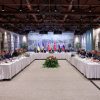Measuring earthquakes is no easy task, given they strike suddenly and sometimes at global scale.
When the Earth’s crust shifts abruptly, an earthquake occurs, with energy radiated out as seismic waves and shaking that’s sometimes experienced by people, buildings and infrastructure.
Seismic waves and factors related to the shifting ground determine an earthquake’s magnitude, as measured through 10 on the scale most commonly used to describe quakes.
How strong the shaking feels is an earthquake’s intensity, as measured on a scale that uses Roman numerals to assign categories based on assessed damage and people’s observations.
Here’s what the scales indicate:
Measuring an earthquake’s magnitude
Scientists largely use the moment magnitude scale to categorize earthquakes’ strength and size in a way that’s more accurate than the long-used Richter scale, the US Geological Survey says.
This moment magnitude scale is based on the earthquake’s “seismic moment,” which accounts for how far the Earth’s crust shifts in a quake, the size of the area along the crustal crack and the force required to overcome friction at that spot, along with the seismic waves the shift creates.
The moment magnitude will be larger if there is more friction and shifting across a longer distance. Seismic waves are measured by seismometers, which use a pendulum attached to a spring that moves with the shaking of the Earth, generating a kind of graph called a seismogram.
Magnitude is ranked through 10, with each whole-number increase equal to 32 times more energy released.
Measuring an earthquake’s intensity
The intensity of an earthquake is measured using the Modified Mercalli Intensity, or MMI, Scale.
It measures the strength of an earthquake’s shaking at specific locations around its epicenter – the spot on Earth’s surface directly above a quake’s underground origin.
The MMI scale uses Roman numerals I through X (1 through 10) to determine how intense an earthquake was based on structural damage assessments and reports from observers.
Intensity is important to consider since the terrain, depth, location and many other factors play a significant role in the devastation an earthquake can cause.







































